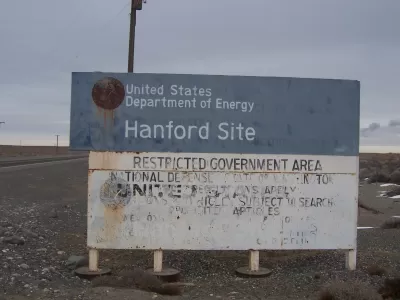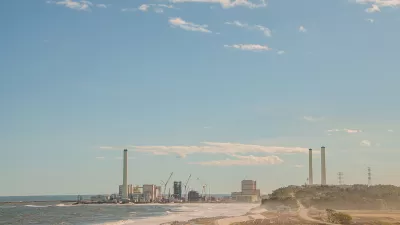A cleanup of nuclear weapons waste at Washington State's Hanford Site was first outlined in 1989. But now, as state officials wrangle with the federal government, deadlines set in 2016 may still not be met.

Washington's Hanford Site once played host to the Manhattan Project. Over the past several decades, it's been the site of one of the nation's largest nuclear cleanup efforts. But as Ralph Vartabedian reports, delays abound.
"Two multibillion-dollar industrial facilities intended to turn highly radioactive sludge into solid glass at the Hanford nuclear site have been essentially mothballed. Construction was halted in 2012 because of design flaws and Energy Department managers have foundered in finding alternatives," Vartabedian writes. Meanwhile, the storage of 56 million gallons of radioactive waste so close to the Columbia River has raised environmental concerns.
According to the state, "federal officials have taken repeated unilateral actions that will make their cleanup unlikely to meet critical deadlines set up in a 2016 consent decree in federal court." Part of that stems from cost issues. In February, a new estimate expanded the projects likely bill "from $110 billion to as much as $660 billion, a cost increase that has staggered Congress and has fueled sentiment to cut short the cleanup goals."
State officials are preparing for further legal wrangling to get the project back on track.
FULL STORY: Nation’s most ambitious project to clean up nuclear weapons waste has stalled at Hanford

Study: Maui’s Plan to Convert Vacation Rentals to Long-Term Housing Could Cause Nearly $1 Billion Economic Loss
The plan would reduce visitor accommodation by 25,% resulting in 1,900 jobs lost.

North Texas Transit Leaders Tout Benefits of TOD for Growing Region
At a summit focused on transit-oriented development, policymakers discussed how North Texas’ expanded light rail system can serve as a tool for economic growth.

Using Old Oil and Gas Wells for Green Energy Storage
Penn State researchers have found that repurposing abandoned oil and gas wells for geothermal-assisted compressed-air energy storage can boost efficiency, reduce environmental risks, and support clean energy and job transitions.

Private Donations Propel Early Restoration of Palisades Playground
Los Angeles has secured over $1.3 million in private funding to restore the Pacific Palisades playground months ahead of schedule, creating a modern, accessible space that supports community healing after recent wildfires.

From Blight to Benefit: Early Results From California’s Equitable Cleanup Program
The Equitable Community Revitalization Grant (ECRG) program is reshaping brownfield redevelopment by prioritizing projects in low-income and environmental justice communities, emphasizing equity, transparency, and community benefits.

Planting Relief: Tackling Las Vegas Heat One Tree at a Time
Nevada Plants, a Las Vegas-based nonprofit, is combating the city’s extreme urban heat by giving away trees to residents in underserved neighborhoods, promoting shade, sustainability, and community health.
Urban Design for Planners 1: Software Tools
This six-course series explores essential urban design concepts using open source software and equips planners with the tools they need to participate fully in the urban design process.
Planning for Universal Design
Learn the tools for implementing Universal Design in planning regulations.
Ascent Environmental
Borough of Carlisle
Institute for Housing and Urban Development Studies (IHS)
City of Grandview
Harvard GSD Executive Education
Toledo-Lucas County Plan Commissions
Salt Lake City
NYU Wagner Graduate School of Public Service



























